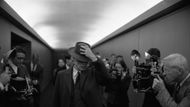Nolan’s Oppenheimer presents you with all the huge moments: the race to make the bomb, the big test, as well as the explosion everyone talks about. Sure, those scenes are loud and wild. But honestly, the scene that hits the hardest comes later. Oppenheimer stands in front of a cheering crowd, after the bomb has already destroyed Japan.
Instead of excitement, you feel something heavy. You see the guilt on his face. He looks scared and alone, even with everyone around him. This quiet scene in Oppenheimer reveals the true cost of his actions. It sticks with you way more than the blast.
Why is Oppenheimer’s most important scene not about the bomb?

The build-up to the “expected” climax
Most of the movie leads up to the Trinity test: you watch Robert Oppenheimer and his team as they fret, feeling the pressure from the government, and fearing that they might set the whole sky on fire. The film keeps hinting that this explosion is the big moment. When the test happens, it really stands out. Nolan drops the sound right when the bomb goes off, so you sit with the silence until the shockwave hits. It’s a strong scene and pretty hard to forget.
But the most important moment comes right after. It isn’t about science or big explosions anymore. Instead, it’s just Oppenheimer standing up in front of people. That’s when the real emotion of the film kicks in.
The scene with the crowd
After the U.S. drops the bombs on Hiroshima and Nagasaki, Oppenheimer stands in front of all the Los Alamos workers. They cheer and stomp their feet. They think they’ve just ended the war and saved lives. On the outside, it feels like an achievement, a massive win. But Nolan decides to present the audience with Oppenheimer's perspective. We watch and hear what he imagines.
Instead of happy cheers, the physicist hears screams in his mind. He doesn’t see proud faces; he pictures burnt skin and bodies. At one moment, the floor feels like it’s shaking, almost like the bomb blast happened right there with him. The sounds twist and turn into something terrifying; the lights hurt; and the celebration starts feeling like a nightmare.
This is the first time we clearly see the weight of his guilt. He is aware that while the crowd celebrates, thousands of civilians are being vaporized overseas. The bomb is not just a contribution to science anymore; it is horror, and he can neither escape the reality of it nor stop it.

Why does this scene matter more than the Trinity test?
The Trinity test is a demonstration of Oppenheimer’s success as a scientist. On the contrary, the crowd scene is a depiction of his failure as a human being. Together, they create a juxtaposition that defines his story and this biopic. But the second scene is the one that reveals the man behind the legend.
At Trinity, he stands in awe of what he created. In the crowd scene, he is horrified by the consequences of his creation. This switch makes the film less about a scientific breakthrough and more about the moral burden that follows. It captures his isolation. We see everyone around him is cheering, but the character feels alone. His mind is far away from the crowd, as though he is part of a completely different reality.
This isolation explains why, later, he struggles with the government, politics, and his own conscience. It is the birth of the myth. The line is often linked to the infamous physicist that connected to this weight of guilt
“Now I have become Death, the destroyer of worlds."
This scene is where he fully begins to comprehend the scale, impact, and meaning of his creation. The bomb made him famous, but it also cursed him, and more importantly, it cursed the people who had to suffer the consequences of the drop.
How Nolan films the scene

The power of this moment comes not from action but from Nolan's filmmaking choices. Nolan strips away the normal rules of a “celebration” scene.
The sound design totally puts you in focus. The cheers fade and twist into distorted noises. A woman suddenly screams, but her scream feels totally out of place. It actually sounds like she just went through the explosion herself. Because of that, the audience gets pulled right into the protagonist's shaky mind.
Visuals are worth mentioning. Instead of showing smiling faces clearly, Nolan uses blinding light, trembling shots, and even the image of a woman’s skin peeling off in his imagination. The happy scene transforms into something ineffably nightmarish.
And what is the perspective? Everything is seen through the protagonist's eyes. We are trapped with him, feeling what he feels. This personal focus makes the moment more unsettling than the massive desert explosion.
The historical significance

The scene reflects history. Reports suggest that Oppenheimer did feel pride when the bomb was first used, but his guilt grew quickly. He later visited President Truman and admitted he felt that he had “blood on his hands”. Truman angrily dismissed him, calling him too emotional. This historical tension is condensed in Nolan’s film into that one crowd moment. It depicts how morality often clashes with power.
What does the scene say about humanity?
Nolan skips the usual explosion scenes and zooms in on one moment. This choice makes the story about the protagonist's decisions, not just the bomb itself. It is about the cost of human choices. The crowd cheers like they just won a prize, but they ignore the pain behind it all.
Oppenheimer’s troubled look symbolises he can neither forget nor ignore the consequences of his creation. Although the creation of tools to seize power might be a morally rewarding incentive, the repercussions of using them are rarely ever anything short of devastating. Once inventions are made public, tested, and utilised, the ramifications cannot be reversed. The guilt isn’t just the physicist's personal moral dilemma; the wreckage belongs to everyone.
Comparing this scene to other war films
Most war narratives just throw explosions and battles in your face. Nolan did the opposite in Oppenheimer. He skips the predictability of portraying the dropping of bombs on Hiroshima or Nagasaki. Instead, he focuses on Oppenheimer’s face: you see him go through different emotions, his fear as well as guilt. This choice makes the story feel more personal and real, and the crowd scene feels much heavier than any explosion.

It isn’t about showing off: it is about the moral weight of their decision. The Trinity test is a demonstration of progress in science and power, but the scene with the crowd illustrates the hard truth to swallow about the ramifications of his creation.
How this shapes the rest of the film
After this scene, the protagonist's path changes. His conflicts with government officials, his fears about nuclear arms races, and his eventual downfall – all connect back to that moment of guilt. Without the crowd scene, his later struggles would not carry the same weight. It provides context for why he warned against using the bomb further and why he later ended up becoming a controversial figure in America.
This scene is significant because it reveals the disparity between the celebration and Oppenheimer's true feelings: a man struggling with the consequences of his scientific pursuit.
Love movies? Try our Box Office Game and Movie Grid Game to test your film knowledge and have some fun!
